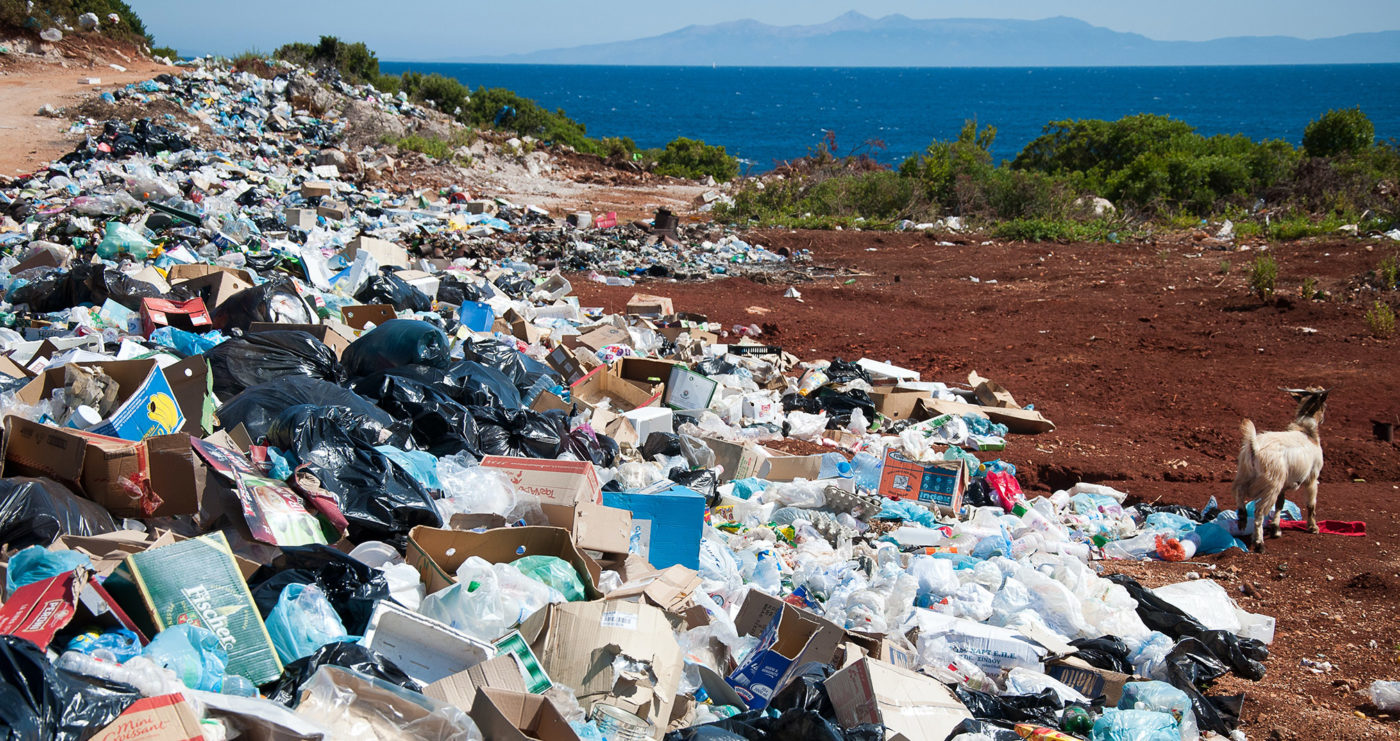What is Solid Waste
Solid waste is the unwanted, discarded solid materials which arise from human or animal activities. Solid waste management is the process of collecting, transporting, and treating solid waste. This waste generates from industrial, commercial, or residential operations. Solid waste can be simply categorized as follows.
- Organic waste – kitchen waste, food waste, animal waste
- Construction waste – concrete, rubber, metals, roofing
- Combustibles – paper, wood, dry organic materials
- Non-combustibles – metals, stones, tins, bottles
- Recyclables – plastic, glass, metals, paper, polythene
- Toxic waste – chemicals, paints, fertilizer containers, expired medicines, spray cans, pesticide containers, shoe polish, bulbs
- Hazardous waste – Hospital waste, industrial waste, batteries, radioactive waste
- Bulky waste – tree branches, tires
Hazardous waste can be explosives, flammable, volatile, radioactive, toxic, or infective. Therefore, it requires particular precautions in its storage, collection, transportation treatment, or disposal to prevent damage to persons or property.
Importance of Solid Waste Management
Improper solid waste handling can cause litter surrounding, which affects the environment as well as the community. And also, improper solid waste disposal can affect public health, the health of the people who live nearby the polluted area as well as waste disposal workers. Degradation of biodegradable materials in an improper solid waste dumps provide conditions for the growth of disease-causing pests. An ineffective solid waste management system can cause critical negative environmental impacts such as land and water pollution, infectious diseases, obstruction of drains, and loss of biodiversity.
Releasing toxic and hazardous waste can cause severe problems to the surrounding environment, such as groundwater contamination, soil pollution, air pollution, and, thereby, adverse effects for animals and aquatic lives. Thus, proper solid waste management practices are crucial for the sustainable development of a community. The entire population’s health and protection depend on it.
Solid Waste Management Process
Solid waste management is the process of collecting, transporting, and treating solid waste for further using it as a valuable resource or disposing of it in a way reducing the effect for the environment. The proper waste handling process should take into account environmental impact, public health, economic, and engineering considerations.
Solid waste management practices can be varying according to industrial or domestic, rural, or urban and developed or developing economies. Solid waste can be either hazardous or non – hazardous. Generally, the management of solid waste in a metropolitan area is the responsibility of local government authority. In contrast, the management of hazardous solid waste is the responsibility of the organization that generates it as subjective to the respective body.
The solid waste management process consists of the following significant steps.
- Generation of waste
- Waste handling, storage, and processing on-site
- Collection of waste
- Waste transfer and transport
- Waste processing and recovery
- Disposal of waste
Integrated Solid Waste Management (ISWM)
Integrated Solid Waste Management is a comprehensive system of waste reduction, collection, recycling, composting, and disposal. This system considers how to reduce, reuse, recycle, and manage waste, thereby protecting the natural environment and human health. The amount of total waste produced can reduce as well as that waste can appropriately manage by employing an integrated solid waste management system.
Key elements of the integrated solid waste management systems are as follows.
- Source reduction
- Reuse and Recycling
- Waste transportation
- Treatment and disposal
Source Reduction
Source reduction prevents unnecessary waste generation at the source. This reduces the waste handling, transportation, and disposal costs. Source reduction can employ by numerous approaches such as
- Product manufacturing and packaging using fewer materials
- Minimizing the use of virgin materials in consumer products
- Penalize generators for increasing waste quantities
- Introduce reusable products
- Introduce recyclable products and packages
- Reduce food spoilage by proper processing and storage
Reuse and Recycling
Reusing means using something more than once. Reusable materials have a longer life span and don’t throw away after the first use. A lot of home waste materials can reuse for different purposes. Thus, people should think about reusing before throwing away something. Reuse leads to reduce some amount of waste materials collected.
Recycling and Reuse are critical stages of the solid waste management process. The recycling process converts waste materials into useful materials or products. Waste accumulation, sorting and recovering of recyclable and reusable materials, and reprocessing of recyclable materials are the steps involves with the recycling process.
Glass, plastics, metals, paper and cardboard, polythene are examples for recyclable materials. Waste materials can collect to a central separation unit and then separate using techniques like magnetic separation, optical separation, air or water classification, and inertial classifiers. Currently, in a lot of countries, the respective authority collects separated waste at the source as food waste, polythene, and cardboard, glass, plastic. It is favorable for the recycling process. Generally, these waste materials clean before subjected to the recycling process.
Recycling can be done in different structures. In internal recycling, recycled materials are used for the same process or different processes within the process industry where waste is generated. Recycling cell is an external recycling structure that exchanged recycled content with a legally and economically independent sector.
Composting is an organic recycling process. Composting is a process of collecting organic waste and convert it to manure, which can be used for gardening. Recycling and composting convert waste materials to a useful product, thereby, reduce material usage, generate a cost-effective source of materials, and reduce greenhouse gas emissions.
Waste Transportation
Waste transportation engages with other waste management activities in a systematic way. This includes the collection of waste from industry or residential areas and transport to the main waste collection center, transport sorted waste to recycling facilities, or deliver to landfill. The type and the condition of waste is an essential factor to consider in waste transportation.
Treatment and Disposal
Waste materials that cannot be recycled subjected to disposal by incineration, landfilling, or pyrolysis. Waste disposal methods must manage appropriately to prevent advice effects on the environment as well as to the nearby community.
Sanitary land-filling
Sanitary landfilling is a popular method of solid waste disposal. There, waste materials isolated from the environment until they completely degrade biologically, chemically, and physically. Sanitary landfill is a pit that has a protected bottom and trash buried in layers and compressed. This method ensures the safe decomposition of accumulated waste even though it requires a larger area.
There are multiple levels of layers to favorable for the waste decomposition and also trap toxic gases releasing to the environment.
First layer – Liner system
This is the bottom layer of the landfill, made out of compact and well dense clay to avert leakage of liquids in or out. This layer is completely impermeable. A high-density polythene layer added on the top of the clay for reinforcement. This is to ensure there is no groundwater contamination.
Second layer – Drainage system
Some toxic liquids are produced from the decomposition of waste materials. The drainage system allows collect and drain away fluids before reaching the liner system. This liquid may contain some compounds which can degrade the liner system. The piping system on the top of the liner allows the collection of leachate and drain away it to a treatment plant for further treatments.
Third layer – Gas collection system
This system ensures the collection of gases released during the waste decomposition. Methane is the most produced gas, which can cause different environmental problems. Extraction pipes of the gas collection system trap methane gas and send it to treatments. After that, it can be used as an energy resource.
Fourth layer – Waste materials
The top and the most extensive layer is waste. The garbage collected from various resources are dumped in here and compact daily. The landfill should be covered when with layers of sand, clay soil, and gravel to prevent seepage of water when it is filled. Soil prevents terrible smells and growth of pests and flies. Landfills are very deep and can take several years to completely filled.
The layering of garbage and soil in landfills, speed up the decomposition process. The generated methane gas from decomposition can use for electricity generation, instead of releasing to the atmosphere, as it is a toxic gas. Sanitary landfills should be appropriately designed, well-constructed, and systematically managed.
Incineration
Incineration developed as an alternative waste management option for landfills which ensures smooth and more efficient waste management. It can be simply defined as the process of burning of organic materials in solid waste at high temperatures. It converts waste materials into ashes, flue gas, and heat. Waste to energy plants use incinerators that recycle heat energy through furnace and boiler. Metals that can recover removed using magnets from the ashes produced by incineration. Remaining ashcan use in construction as an aggregate or can send to landfills.
This method can decrease the volume of waste by up to 30%, thereby saving the transportation cost. Furthermore, incineration reduces the need for landfills and gives energy as a byproduct. However, incineration can cause adverse effects due to smoke generation and the emission of gaseous pollutants. This leads to considerable health and environmental risks to nearby communities.
Pyrolysis
Pyrolysis is a solid waste management solution that facilitates energy and resource recovery. Organic wastes thermally degrade by heat in the absence of oxygen during the pyrolysis process. This process carried out under high temperatures and pressure. Solid waste converts into gasses, ashes, solid carbon residues, and a small quantity of liquid.
Municipal waste pyrolysis begins with the mechanical separation of glass, metals, and inert materials before processing the remaining waste to a pyrolysis reactor.
Commonly used pyrolysis reactors are rotary kilns, fluidized bed furnaces, and rotary hearth furnaces. An external heat source requires to maintain the high temperature necessary for the process. The main products obtained from the pyrolysis of municipal wastes are a synthetic gas (syngas) with high calorific value, bio-oil, and char.

